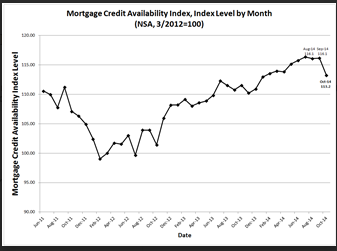I’ve been saying this for a while, higher rates will lead to expanding credit which will further aid economic expansion. Continued low or even falling rates will further restrict credit and retard it. As the 10yr falls, so does credit availability.  Slowly rising rates would be a nice economic benefit right now
Mortgage credit availability decreased in October, according to the Mortgage Credit Availability Index (MCAI), a report from the Mortgage Bankers Association (MBA), which analyzes data from the AllRegs® Market Clarity® product.

The MCAI decreased 2.5 percent to113.2 in October. A decline in the MCAI indicates that lending standards are tightening, while increases in the index are indicative of a loosening of credit. The index was benchmarked to 100 in March 2012.
“The major cause of the decline in the credit index in October was the removal of special loan programs which only pertain to REO sales. These programs were likely discontinued due to the shrinking level of REO properties for sale on the market,†said Mike Fratantoni, MBA’s Chief Economist. “FHFA recently announced plans regarding efforts to expand access to conventional conforming credit through greater clarity with respect to repurchase risk and a modest expansion of higher LTV lending. These changes are not yet finalized and hence are clearly not reflected in the October data.â€
NEW CONVENTIONAL AND GOVERNMENT COMPONENT INDICES
Last month, MBA began reporting on two additional measures of credit availability as part of the monthly MCAI release: the Conventional Mortgage Credit Availability Index and the Government Mortgage Credit Availability Index, with historical data back to 2011.

The Conventional and Government MCAIs, which are component indices of the Total MCAI, are constructed using the same methodology, and are designed to show relative credit risk/availability for conventional and government (FHA/VA/USDA) loan programs. The difference between the component indices and the total MCAI is first, the population of programs they examine, and second, the “base levels†to which they are calibrated. Using data from the MCAI and our Weekly Applications Survey, MBA calibrated the Conventional and Government indices to better represent where each index might fall in March 2012 (the “base periodâ€) relative to the Total= 100 benchmark.

